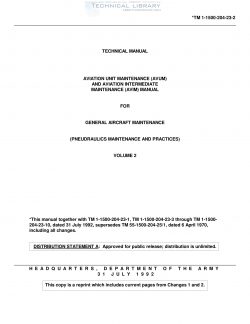ARMY-TM-1-1500-204-23-2
- Version
- 287 Downloads
- 2.37 MB File Size
- 1 File Count
- March 5, 2017 Create Date
- March 5, 2017 Last Updated
▼ Scroll for Details ▼
Pheudraulics Maintenance and Practices - Vol. 2

1-1. Purpose. This volume provides general information pertaining to aircraft hydraulic and pneumatic systems. The application of materials and techniques used on specific aircraft is not covered In this volume. Specific aircraft application, usage, and substitution are found in the individual aircraft maintenance manuals This volume is of maximum benefit to the mechanic who desires information about tubing systems, flexible hoses, packings and O-rings, and aircraft system components. This volume furnishes the mechanic a source of information about how to perform various mechanical functions which are used on all aircraft This volume is not a requisitioning authority, and applicable repair parts and special tools list should be consulted to obtain the unit of Issue and National Stock Number of the Items required for maintenance. 1-2. Scope. General information to guide aircraft maintenance personnel is covered within this volume; however, no attempt has been made to include special parts or equipment which are applicable only to individual or specific aircraft General information on aircraft hydraulic systems is contained lnCfiÅöiéö2]and hydraulic shop operations are discussed Procedures, techniques, and materials for maintenance of tubing, hoses, ackin s O-rings, reservoirs, filters, pumps, accumulators, valves, brake systems, and absorbing units are presented in 1-3. Consumable Materials. Refer to TM 1- 1500-204-23-6 for consumable materials in this volume.
2-1. Pneudraulics Theory and Basic Principles. The aircraft hydraulic system transmits engine power to distant points on the aircraft. This force is carried by hydraulic fluid confined In a system of tubing and hoses Q.ua.llties-QLHY.dæuLc-Eluid. Hydraulic fluid can be described In terms of three physical qualities a. (1) Incompressibility. For practical purposes, liquids are incompressible This means that even under extremely high pressure a liquid cannot be made much smaller. (2) Expansion and contraction. Liquids expand and contract with changes in temperature. When a liquid in a closed container is heated, the liquid expands and puts pressure on the walls of the container. As the liquid cools, the pressure decreases. (3) Pressure transmission. Pressure applied to a confined liquid is transmitted equally. If an opening exists in a system, such as an actuator, the fluid will act on it, causing it to move.
| File | Action |
|---|---|
| ARMY-TM-1-1500-204-23-2 Pheudraulics Maintenance and Practices - Vol. 2.pdf | Download |
Comment On This Post